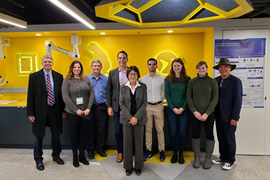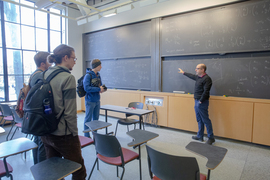The U.S. Department of Defense (DoD) recently announced the recipients of its Multidisciplinary University Research Initiative (MURI) awards for 2023. This year, MIT Department of Mechanical Engineering (MechE) professors George Barbasthasis and John Hart, MIT Department of Electrical Engineering and Computer Science (EECS) Assistant Professor Pulkit Agrawal, and MIT Department of Materials Science and Engineering Associate Professor Rob Macfarlane are principal investigators on projects selected for MURI Awards. Two others from MIT — Ila Fiete, a professor in the Department of Brain and Cognitive Sciences, and Aude Oliva, MIT director of the MIT–IBM Watson AI Lab, director of strategic industry engagement in the MIT Schwarzman College of Computing, and a senior research scientist at the MIT Computer Science and Artificial Intelligence Laboratory (CSAIL) — will be participating in these projects.
In addition, three MURI projects led by faculty at other institutions will be collaborating with other MIT researchers. The 2023 MURI awards total $220 million and will fund 31 research projects at an extensive list of institutions.
The MURI program is designed to support research in areas of critical importance to national defense, and brings together teams of researchers from multiple universities to collaborate on projects that are expected to lead to significant advances in science and technology. The program is highly competitive, with only a small fraction of proposals receiving funding each year, and it has a strong track record of supporting research that has led to breakthroughs in fields ranging from materials science to information technology.
Fundamental limits of nanoscale X-ray microscopy in radiation-sensitive materials
One of the funded projects is titled “Searching for what’s new: the systematic development of dynamic X‐ray microscopy.” This will be led by Professor George Barbastathis of MechE, alongside colleagues from Northwestern University and Stony Brook University, and falls within the Fundamental Limits of Nanoscale X-ray Microscopy in Radiation Sensitive Materials MURI topic.
Barbastathis and his team explain that X-ray microscopes offer unique capabilities, but can also be harmful to the small objects they’re taking images of. This team has developed a new approach that puts forward a paradigm shift for higher resolution and the study of dynamics, allowing one to start with knowledge they already have of a specific object, rather than a blank slate. This should allow them to use less harmful X-ray exposures. The team plans to test this approach to study three model systems: small machines, batteries, and cells.
This project is sponsored by the U.S. Air Force Office of Scientific Research and will help the DoD by providing new insights into the function of batteries used in troop-carried electronics, aircraft, and elsewhere; in the response of micro electronic mechanical systems, which are used in the field as sensors; and in the biological response of cells to external stresses and environmental changes.
Spatially programmed material properties via designed mesostructures
John Hart and Rob Macfarlane are co-leading a MURI project entitled “Directed assembly of mesoscale architectures in additive manufacturing,” sponsored by the U.S. Office of Naval Research. The project is in collaboration with professors A.J. Boydston of the University of Wisconsin; Randall Erb and Safa Jamali of Northeastern University; and Arthi Jayaraman of the University of Delaware. The team’s expertise spans chemistry, materials science, simulation, machine learning, machine design, and characterization.
While additive manufacturing can create complex geometries from a wide variety of materials, it is typically not possible to control the architecture of the material at a length scale smaller than the resolution of the additive process. The MURI team will combine additive manufacturing with “bottom-up” directed assembly, using tailored nanoparticle building blocks and polymers, and by building new instruments to study the process and validate computational predictions. The end goal of the project is to realize materials and structures with emergent thermal electromagnetic, and optical properties that could be used in, for instance, cooling of high-power electronics, next-generation communication systems, and high-performance cameras.
Neuro‐inspired distributed deep learning
Pulkit Agrawal, assistant professor in EECS and an affiliate of CSAIL and the MIT Laboratory for Information and Decision Systems (LIDS), leads a third MURI project. Agrawal's team, which includes Ila Fiete and Aude Oliva of MIT as well as researchers from Harvard University and the University of California at Berkeley, proposes an alternative to the mainstream machine-learning practice of condensing large datasets into the weights of deep neural network and discarding the training data itself. Such an approach has fundamental limitations when it comes to lifelong learning and the associated questions of generalization, long-term reasoning, and catastrophic forgetting. As such, the proposal suggests avoiding compressing data ahead of time and instead combining data on-the-fly for the environment or task encountered by the agent, using memory retrieval to improve generalization.
The work aims to articulate a set of high-level computational principles for the design of memory systems, leveraging knowledge about how the brain encodes and retrieves information from memory. It aims to determine how these principles can be leveraged to tackle challenging machine learning tasks, understand how biological memory systems represent and retrieve naturalistic inputs, and help in the integration of AI into a wide variety of real-world systems. Ideally, the end result will yield practical algorithms for generalization to new tasks, lifelong learning without catastrophic forgetting, and transfer across sensory modalities.








